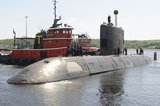Italian Navy finally takes delivery of Trieste
The Trieste, Italy’s new monster landing helicopter deck. (Photo: Fincantieri)
The multipurpose landing helicopter deck Trieste was finally delivered to the Italian Navy on 7 December 2024, nine years after the contract for its construction was awarded to Fincantieri and Finmechanica.
The Trieste is the largest ship built in Italy in the post-war period, and is fitted with advanced technologies that will make it suitable for amphibious operations, logistical support, air missions, and humanitarian interventions.
With a length of 245 metres and displacing 37,770 tons, the Trieste will have a range of 7,000 nautical miles and a top speed of 16 knots.
Related Articles
LHD Trieste sea trials commence
Italy readies LHD Trieste for 2023 delivery, expands F-35 operations
It will be able to accommodate up to four LC-23 landing craft or one LCAC in its floodable dock, and will carry nine spots for aircraft, including F-35Bs, CH-47 helicopters and MV-22s.
In human terms, it will have living space for 1,064 personnel including 360 crew, with the rest of the accommodation split between aviators, support, and command and control staff.
The Trieste will be the flagship of Italy’s Amphibious Task Group (ATG), itself an important part of the Italian Navy's Expeditionary Task Force (ETF).
With a unit cost of US$1.3 billion, added to its long build-time, the Trieste has had to justify its build over time by bringing jobs to Italian manufacturers and technology firms throughout its years of construction.
The Trieste has been assigned to Italy’s 3rd Naval Division, and after initial training in La Spezia, will be homeported at Taranto.
The ceremony to commemorate the delivery of the Trieste was held at the port of Livorno and attended by Italian President Sergio Mattarella.
Related Programmes in Defence Insight
Related Equipment in Defence Insight
More from Naval Warfare
-
![Maritime defence in the Mediterranean faces challenges from vulnerable land power]()
Maritime defence in the Mediterranean faces challenges from vulnerable land power
As an indispensable energy crossroads, the Mediterranean is at serious risk from grey zone disruption. As navies increasingly employ AI data centres, what happens when cutting-edge defence technologies rely on the very infrastructure most susceptible to hybrid tactics?
-
![US Navy to conduct an experimentation campaign with emerging tech in 2026 and 2027]()
US Navy to conduct an experimentation campaign with emerging tech in 2026 and 2027
The Technology Operational Experimentation Events will inform future requirements as the US Navy looks for innovative solutions across three key operational domains.
-
![US Navy to acquire micro-uncrewed underwater vehicles for ISR and coastal data collection]()
US Navy to acquire micro-uncrewed underwater vehicles for ISR and coastal data collection
The Naval Supply Systems Command is seeking authorised resellers of JaiaBot uncrewed underwater vehicles and multivehicle pods. The platforms will support undergraduate education at the US Naval Academy.






















